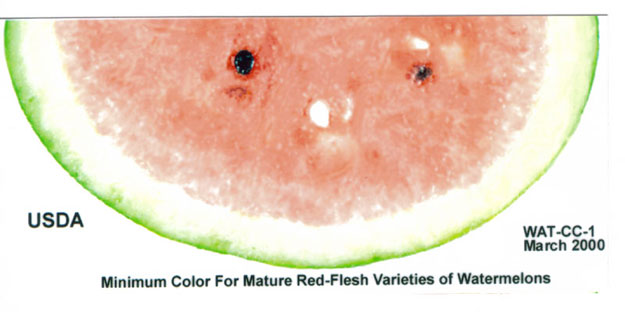Inspecting watermelons can be challenging, especially when you encounter a load of watermelons with maturity problems, or pink to light red color. There are a few external indicators to look for to determine if a watermelon is mature. You would want to see a creamy or yellow color on the ground side of the melon; a filled out appearance in regard to the circumference; rind color breaking from a pea green at the blossom end to a natural darker green color. But the bottom line, you have to cut the watermelon to determine if it is a defect.

Looking at the image above, let’s say you cut the first melon and it doesn’t look too bad….a little light red. Then you cut your second melon and you notice a much deeper red color. Is the first melon a defect? This common occurrence happens all the time. Remember not judge one melon against another, but you have to follow the defect scoring guidelines to determine if the lighter red colored melon is a defect.
Using the USDA scoring guidelines, a U.S. No. 1 Watermelon has to be mature. Mature means the watermelon has reached the stage of development at which the flesh is at least fairly sweet and shows characteristic color of a mature watermelon for the variety.
For red-flesh varieties the USDA has developed a visual aid, a guide to use when determining if a watermelon is mature:

For a watermelon to meet the requirements of a U.S. No. 1 (or a U.S. No. 2) they must meet the minimum color requirement as shown above. If the watermelon is lighter in color than allowed it will be scored as being immature, a serious damage defect. How many watermelons are allowed to be immature and still meet the requirements of the U.S. No. 1 Grade? Only 5% are allowed. The standard sample size is 20 melons, meaning you are allowed 1 melon in every sample to be immature.

2 Comments on “Watermelons- Red Color”
I have noticed a lot of watermelon this year has milky pink areas rather that red or pinkish red. Not only is it a milky color, but the texture and taste is odd as well. I have purchased watermelon in different stores this summer and have found it in almost every case that some or most of the watermelon has this. Do you know what it is and is it safe?
Elizabeth, thanks for your question. Based on your description it sounds like you are finding immature watermelons, melons being picked before they were ready. They are safe to eat, but the taste will be somewhat flat. You would be advised to return the melon to the store you made the purchase and ask for a refund or another watermelon.